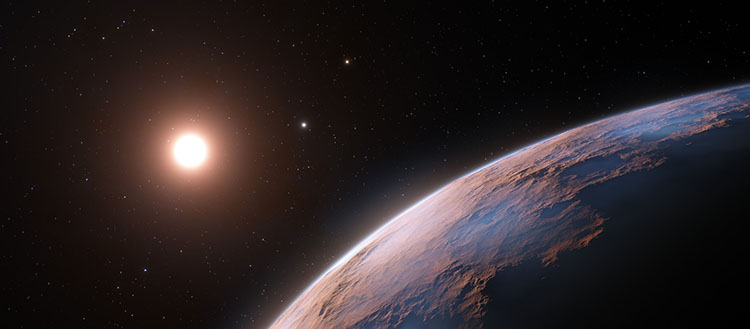ESPRESSO detects the lightest exoplanet
Thanks to the ESPRESSO spectrograph developed at the UNIGE, an international team has discovered an ultralight exoplanet in orbit around Proxima Centauri, our closest neighbour.

Proxima d orbits the red dwarf star Proxima Centauri, the closest star to the solar system. (c) ESO/L. Calçada
An international team including researchers from the University of Geneva (UNIGE) has detected a third candidate planet around our closest neighbor, the star Proxima Centauri. Named Proxima d, this planet is the lightest ever detected with the radial velocity technique. Its mass is about a quarter of that of the Earth. It orbits its star in 5.12 days. The data, of unprecedented precision, were collected using ESPRESSO, the state-of-the-art spectrograph developed by the UNIGE and installed on the European Southern Observatory's (ESO) Very Large Telescope, located in the Atacama Desert in Chile. This new record dethrones that of another planet, L 98-59 b, also detected by UNIGE researchers with ESPRESSO, only a few months ago. This discovery confirms the increasing power of this high-precision Swiss instrument and promises new scientific advances in our understanding of planetary systems. These results can be read in Astronomy & Astrophysics.
The ESPRESSO spectrograph has been making radial velocity measurements - a technique for observing the motion of a star - on the star Proxima Centauri, just 4.2 light-years from the Sun, for almost 100 nights to detect the small variations associated with the presence of a third planet with an accuracy of less than 10 cm/s. "I am delighted to see ESPRESSO achieve the precision goal we set for it," says Francesco Pepe, Director of the Astronomy Department of the Faculty of Science at the University of Geneva (UNIGE) and head of ESPRESSO. "It is a huge satisfaction for this teamwork started fifteen years ago."
The newly discovered planet, named Proxima d, orbits Proxima Centauri at a distance of about four million kilometres, less than one-tenth the distance from Mercury to the Sun. It lies between the star and the habitable zone - the area around a star where liquid water can exist on the surface of a planet - and takes only five days to complete an orbit around Proxima Centauri. "This discovery shows that our closest stellar neighbour seems to be full of interesting new worlds, within reach for future study and exploration," explains João Faria, researcher at the Instituto de Astrofísica e Ciências do Espaço, Portugal, and lead author of the study.
A meticulous investigation
"We now know that our closest neighbour, Proxima Centauri, is home to several interesting planets," confirms David Ehrenreich, co-author of the study and professor in the Department of Astronomy at the UNIGE Faculty of Science. Two other planets, Proxima b and Proxima c, were discovered a few years ago with another instrument built by the Geneva researchers, the HARPS spectrograph, mounted on ESO's 3.6-metre telescope. The discovery was then confirmed in 2020 when the scientists observed the Proxima system with ESPRESSO, an instrument mounted on the ESO telescope and among the most precise in the world.
It was during these more recent observations that astronomers spotted the first evidence of an object with a five-day orbit. The signal was very weak, so the team had to make follow-up observations with ESPRESSO to confirm that it was indeed a planet and not just the result of physical phenomena related to the star itself.
A long-term goal
The discovery of this planet brings the number of planets orbiting the closest star to the Sun to three. But there is nothing surprising about this plurality in our neighboring star; since the discovery of 51 Peg b by the two Swiss Nobel Prize winners Michel Mayor and Didier Queloz in 1995, astronomers have demonstrated that planets are common in our Galaxy.
For the Proxima Centauri planetary system, the UNIGE researchers are already preparing a new instrument, RISTRETTO, which will enable them to directly observe the light of the star reflected by its planets. "Thanks to this instrument, we will be able to probe the possible atmosphere of Proxima b and Proxima d in order to detect the presence of molecules such as oxygen or carbon dioxide," says Christophe Lovis, professor in the Department of Astronomy at the UNIGE Faculty of Science, co-author of the Proxima study and principal investigator of this new Geneva-based instrument. RISTRETTO will pave the way for the HIRES (high resolution spectrograph) instrument that will be mounted on the giant 39-metre European telescope, the ELT.
10 Feb 2022